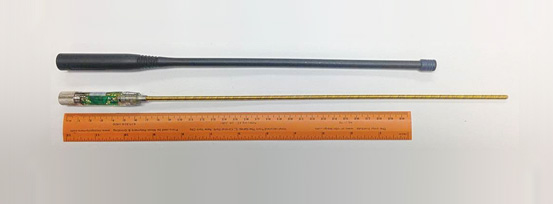When it comes to the production of complex over-molded parts, we like to start the conversation with our clients early in the process. At PDI Molding, we created a cross-functional team with a customer in the defense industry to establish the product specifications, choose the material, and design the mold for the handheld antenna pictured here.
Measuring 330 mm in length x 18 mm in width and with a thickness of 1.60 mm, this antenna was made from an aromatic polyester-base thermoplastic with 45 shore D hardness molded over flexible steel wire and a circuit board. We utilized our vertical clamp injection molding machine and two different molds. For the first mold, we over-molded the whip portion of the antenna while keeping the flexible steel wire stable and centralized as the heated plastic was injected. We then incorporated the second tool to over-mold a water-tight cup over the whip. Built to uphold ±0.10 mm tolerances, both molds were chemically etched to create the textured finish.
Quality assurance procedures involved adhesion testing of the over-mold, validation of the dimensional and concentricity measurements, and cosmetic inspection of the surfaces. We currently manufacture this part in various quantities to meet the company’s production flows. Contact us today to learn more about this project or how our engineering and injection molding capabilities can improve your next project.
Notes:
PDI Molding produces custom over-molded handheld antenna that is 330 mm long with wall thickness of 1.60 mm. Antenna is made of aromatic polyester-base thermoplastic with shore hardness of 45D which is over molded over flexible steel wire & electronic circuit board. We worked with the customer throughout the design, development and material selection stage to ensure their design is moldable. One of the challenges that we had to overcome is to develop a process to keep flexible steel wire centralized during injection process, and to over mold a cup that is water tight.
Each part is molded utilizing veridical clamp injection molding machine using two different molds, one to over-mold whip portion of the antenna and second one is to over-mold a cap over the whip.
Parts are molded with tolerances of ±0.10 mm

